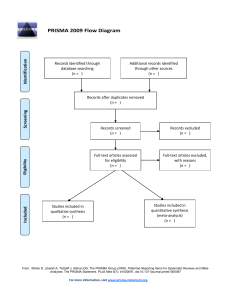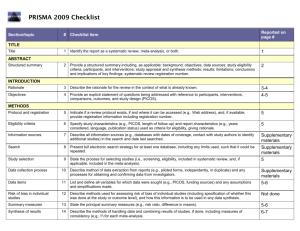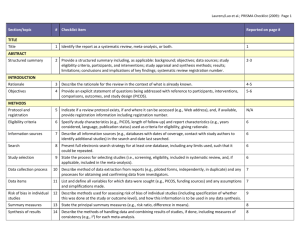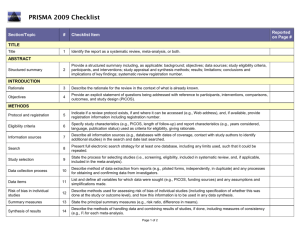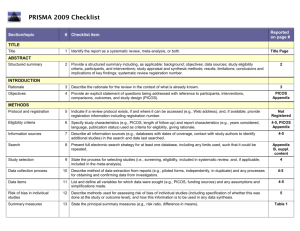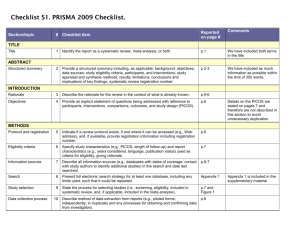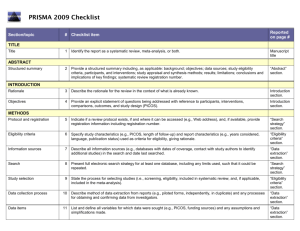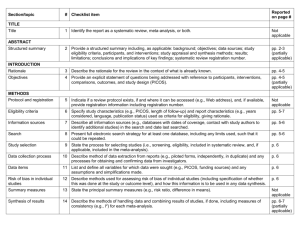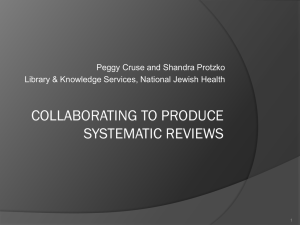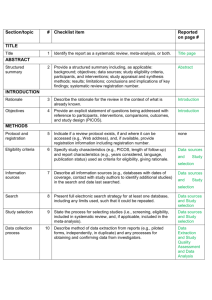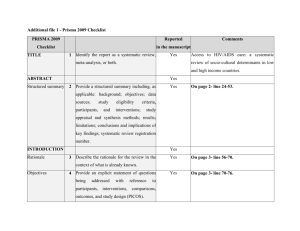Eligibility
advertisement
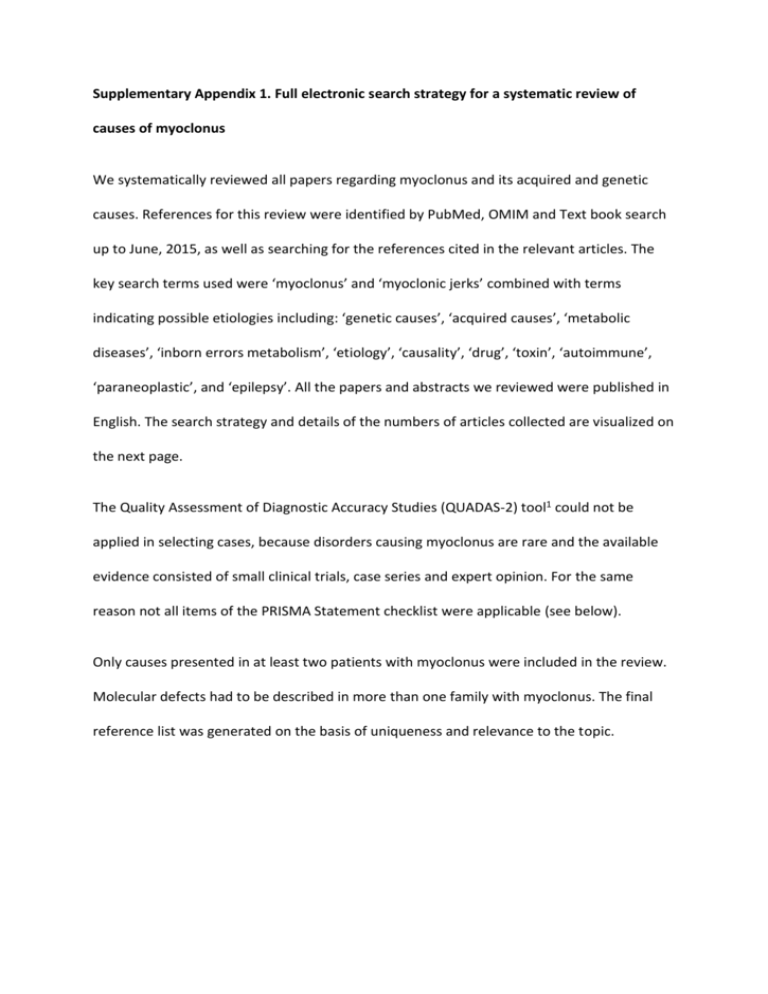
Supplementary Appendix 1. Full electronic search strategy for a systematic review of causes of myoclonus We systematically reviewed all papers regarding myoclonus and its acquired and genetic causes. References for this review were identified by PubMed, OMIM and Text book search up to June, 2015, as well as searching for the references cited in the relevant articles. The key search terms used were ‘myoclonus’ and ‘myoclonic jerks’ combined with terms indicating possible etiologies including: ‘genetic causes’, ‘acquired causes’, ‘metabolic diseases’, ‘inborn errors metabolism’, ‘etiology’, ‘causality’, ‘drug’, ‘toxin’, ‘autoimmune’, ‘paraneoplastic’, and ‘epilepsy’. All the papers and abstracts we reviewed were published in English. The search strategy and details of the numbers of articles collected are visualized on the next page. The Quality Assessment of Diagnostic Accuracy Studies (QUADAS-2) tool1 could not be applied in selecting cases, because disorders causing myoclonus are rare and the available evidence consisted of small clinical trials, case series and expert opinion. For the same reason not all items of the PRISMA Statement checklist were applicable (see below). Only causes presented in at least two patients with myoclonus were included in the review. Molecular defects had to be described in more than one family with myoclonus. The final reference list was generated on the basis of uniqueness and relevance to the topic. Identification PRISMA 2009 flow diagram Records identified through database searching (n = 8,975) Additional records identified through other sources (n = 35) Included Eligibility Screening Records after duplicates removed (n = 9,010) Records screened (n = 1289) Records excluded (n = 751) Full-text articles assessed for eligibility (n = 538) Full-text articles excluded, with reasons (n = 279) Studies included in qualitative synthesis (n = 259) Studies included in quantitative synthesis (metaanalysis) (n = NA) Modified with permission from Public Library of Science © Moher D. et al. Preferred reporting items for systematic reviews and meta-analyses: The PRISMA Statement. PLoS Med. 6, e1000097 (2009), which is an open-access article distributed under the terms of the Creative Commons Attribution License, which permits unrestricted use, distribution, and reproduction in any medium, provided the original author and source are credited. This is an open-access article distributed under the terms of the Creative Commons Attribution License, which permits unrestricted use, distribution, and reproduction in any medium, provided the original author and source are credited. PRISMA 2009 checklist # Checklist item Reported on page # 1 Identify the report as a systematic review, meta-analysis, or both. NA 2 Provide a structured summary including, as applicable: background; objectives; data sources; study eligibility criteria, participants, and interventions; study appraisal and synthesis methods; results; limitations; conclusions and implications of key findings; systematic review registration number. NA Rationale 3 Describe the rationale for the review in the context of what is already known. 1–2 Objectives 4 Provide an explicit statement of questions being addressed with reference to participants, interventions, comparisons, outcomes, and study design (PICOS). NA Protocol and registration 5 Indicate if a review protocol exists, if and where it can be accessed (e.g., Web address), and, if available, provide registration information including registration number. NA Eligibility criteria 6 Specify study characteristics (e.g., PICOS, length of follow-up) and report characteristics (e.g., years considered, language, publication status) used as criteria for eligibility, giving rationale. 9/ Suppl. 1 Information sources 7 Describe all information sources (e.g., databases with dates of coverage, contact with study authors to identify additional studies) in the search and date last searched. 9/ Suppl. 1 Search 8 Present full electronic search strategy for at least one database, including any limits used, such that it could be repeated. Suppl 1 Study selection 9 State the process for selecting studies (i.e., screening, eligibility, included in systematic review, and, if applicable, included in the meta-analysis). 9/ Suppl. 1 Data collection process 10 Describe method of data extraction from reports (e.g., piloted forms, independently, in duplicate) and any processes for obtaining and confirming data from investigators. NA Data items 11 List and define all variables for which data were sought (e.g., PICOS, funding sources) and any assumptions and simplifications made. NA Risk of bias in individual studies 12 Describe methods used for assessing risk of bias of individual studies (including specification of whether this was done at the study or outcome level), and how this information is to be used in any data synthesis. NA Summary measures 13 State the principal summary measures (e.g., risk ratio, difference in means). NA Synthesis of results 14 Describe the methods of handling data and combining results of studies, if done, including measures of consistency (e.g., I2) for each meta-analysis. NA Section/topic TITLE Title ABSTRACT Structured summary INTRODUCTION METHODS Page 1 of 2 Section/topic Reported on page # # Checklist item Risk of bias across studies 15 Specify any assessment of risk of bias that may affect the cumulative evidence (e.g., publication bias, selective reporting within studies). NA Additional analyses 16 Describe methods of additional analyses (e.g., sensitivity or subgroup analyses, meta-regression), if done, indicating which were pre-specified. NA Study selection 17 Give numbers of studies screened, assessed for eligibility, and included in the review, with reasons for exclusions at each stage, ideally with a flow diagram. Prisma flow chart Study characteristics 18 For each study, present characteristics for which data were extracted (e.g., study size, PICOS, follow-up period) and provide the citations. NA Risk of bias within studies 19 Present data on risk of bias of each study and, if available, any outcome level assessment (see item 12). NA Results of individual studies 20 For all outcomes considered (benefits or harms), present, for each study: (a) simple summary data for each intervention group (b) effect estimates and confidence intervals, ideally with a forest plot. NA Synthesis of results 21 Present results of each meta-analysis done, including confidence intervals and measures of consistency. NA Risk of bias across studies 22 Present results of any assessment of risk of bias across studies (see Item 15). NA Additional analysis 23 Give results of additional analyses, if done (e.g., sensitivity or subgroup analyses, meta-regression [see Item 16]). NA Summary of evidence 24 Summarize the main findings including the strength of evidence for each main outcome; consider their relevance to key groups (e.g., healthcare providers, users, and policy makers). NA Limitations 25 Discuss limitations at study and outcome level (e.g., risk of bias), and at review-level (e.g., incomplete retrieval of identified research, reporting bias). NA Conclusions 26 Provide a general interpretation of the results in the context of other evidence, and implications for future research. 9 RESULTS DISCUSSION FUNDING Funding 27 Describe sources of funding for the systematic review and other support NA (e.g., supply of data); role of funders for the systematic review. Modified with permission from Public Library of Science © Moher D. et al. Preferred reporting items for systematic reviews and meta-analyses: The PRISMA Statement. PLoS Med. 6, e1000097 (2009), which is an open-access article distributed under the terms of the Creative Commons Attribution License, which permits unrestricted use, distribution, and reproduction in any medium, provided the original author and source are credited. 1. Moher D., Liberati A., Tetzlaff J., Altman D. G. & The PRISMA Group Preferred reporting items for systematic reviews and meta-analyses: The PRISMA Statement. PloS. Med. 6, e1000097 (2009). For more information, visit: www.prisma-statement.org. Page 2 of 2
